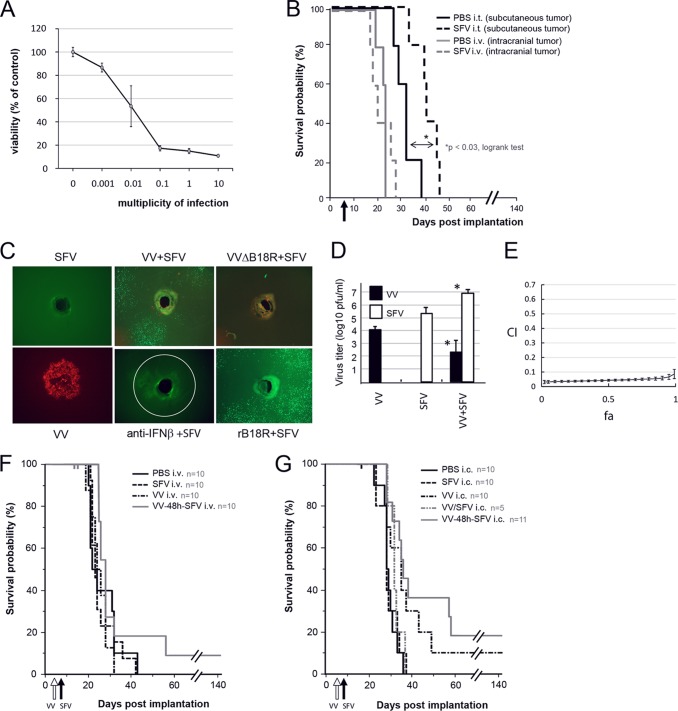Fig 1.
Vaccinia virus facilitates replication of Semliki Forest virus in mouse glioma cells in culture but not in vivo. (A) Dose-dependent killing of BALB/c mouse DBT glioma cells by SFV in vitro, assessed by alamarBlue measurement from triplicate wells 48 h postinfection. (B) Apart from a transient delay in subcutaneous DBT tumor growth upon a single intratumoral injection of 108 PFU SFV, efficacy of SFV in the DBT model is lacking. (C) Plaque expansion assay (20) in DBT cell monolayers in 6-well plates showed that while SFV is unable to spread on its own under agarose, VV coinfection as well as VV-encoded soluble type I interferon scavenger protein B18R (0.1 μg per well; eBioscience, San Diego, CA) and neutralizing polyclonal IFN-β antibody (peripheral blood lymphocyte interferon source) can overcome this restriction, confirming that type I IFN may limit SFV replication in DBT cells. (D) Plaque assay of infected DBT cell culture supernatants (VV MOI, 0.1; SFV MOI, 0.01) shows that while SFV replication is enhanced in DBT cells when SFV is combined with VV at 48 h p.i., replication of VV is significantly inhibited in the presence of SFV (*, P < 0.02 [Mann-Whitney U test]). (E) SFV and VV synergize in cell killing, as measured 72 h postinfection in DBT cells infected with various ratios of VV to SFV. The plot represents the algebraic estimate of the combination index (CI) as a function of the fraction of cells affected (fa) ± the standard deviation, where a CI of <0.7 is considered synergistic. (F) A single systemic injection of 108 PFU of VV followed 48 h later by SFV into mice harboring intracranial (day 6 postimplantation) DBT tumors showed a trend toward increased survival compared to the next treatment, VV alone (P < 0.0729 [log rank test]). One mouse in each of two experiments in the combination group displayed hind leg paralysis and was promptly sacrificed (censored). (G) Survival of mice treated intracranially with 107 PFU virus (sum of two experiments). While the results for the sequential (VV–48-h–SFV) combination were statistically different from those for the VV-SFV-coinjected group and the group receiving SFV alone (P < 0.0132 [log rank test]), they did not differ statistically from those for the group receiving VV alone, which in turn did not differ from those for any other group. Censored animals are shown as small vertical bars along the curves (F and G, top).

